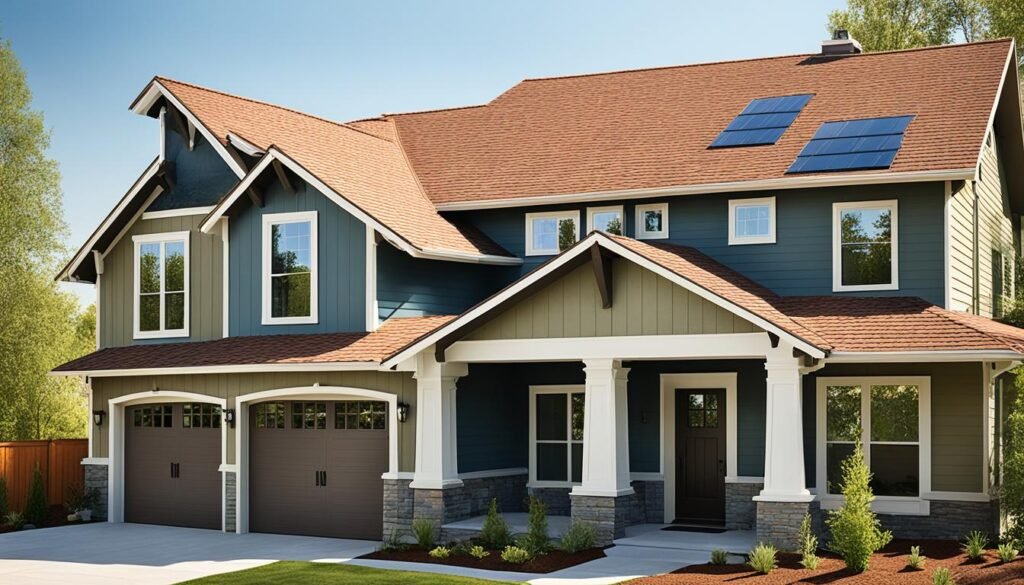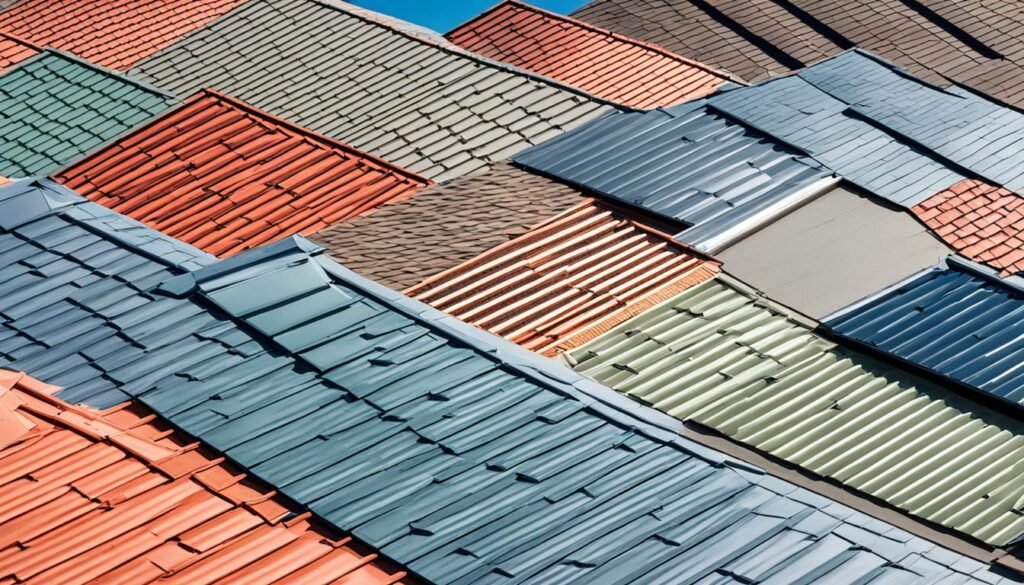On a summer afternoon, a white roof reflects 80% of sunlight, keeping your house 50°F cooler than a grey roof, which reflects only 20%. This info comes from the Lawrence Berkeley National Lab Heat Island Group. It shows that choosing the right roof color can make a big difference in how cool and comfortable your house stays in summer.
Key Takeaways
- Cool roofs are most effective in hot, sunny climates like the Southern U.S., particularly on buildings with low levels of roof insulation.
- Energy savings for buildings with cool roofs in Northern climates are projected to increase as the climate warms.
- The Cool Roof Rating Council (CRRC) offers a wide range of cool roof materials for both sloped and low-sloped roofs.
- Incentives and cool roof requirements are available in certain U.S. locations to promote the use of energy-efficient roofing.
- Roof color can influence a home’s market value and should be considered alongside other factors like cost, quality, and environmental impact.
What Makes a Cool Roof Color Energy-Efficient?
The color of your roof is key for energy efficiency. Cool roof colors, like light ones or those that reflect, help a lot. They lower how much heat your home takes in and make it work better to keep cool.
Paths to a Cool Roof
There are two main ways to get a cool roof:
- Pick cool roof materials when building or fixing your roof. These can be white, light, or have special stuff in them to bounce back up to 90% of the sun’s rays.
- Add reflective roof coatings to your roof. This means putting on a layer that can keep your roof cooler. It might cost more, but it’s a good way to make your old roof act like a cool roof.
Color Choice
White roofs are usually the best at staying cool. They send back most of the sunlight. But, even dark roofs can be energy-efficient. With special tech, they can reflect back a lot of sunlight, choosing what part to send back. These ‘cool-colored’ roofs can keep your place cooler than a usual roof, but a little warmer than white ones.
“Roofing materials with a reflectivity rating higher than 65% are desirable for keeping homes cool during hot summers.”
The solar reflectance index (SRI) is a big part of choosing a cool roof. It looks at how well the roof reflects and sends away heat. A high SRI means the roof is really good at this, making it very energy-efficient.

Choosing the right cool roof color and material can cut down your energy use. This means saving money on cooling and feeling more comfortable at home. It’s also a way to help the earth by building in a smart, long-lasting way.
Cool Roof Color Options for Different Roof Types
The color of our roof affects our home’s energy use. There are many cool colors to pick from. The right choice depends on your roof type. Let’s look at great cool roof colors for every roof style.
Products for Steep Roofs (Pitch > 2:12)
Asphalt shingles, wood shingles, polymer shingles, clay tiles, and concrete tiles are common on steep roofs. Go for light or cool granules in asphalt. Choose cool tones in wood. Look for light or cool pigments in others.
Products for Low-Sloped Roofs (Pitch ≤ 2:12)
On low-sloped roofs, you might find single-ply membranes or built-up roofs. Also, modified bitumen sheet membranes or spray polyurethane foam roofs. For a cool roof, go with reflective surfaces or light pigments. Even reflective ballast on built-up roofs can work.
Products for Steep and Low-sloped Roofs
Metal shingles or tiles and standing-seam metal roofs work for many. For a cool roof, choose from factory-coated paints or reflective granules.
Green (Vegetative) Roofs
Green roofs, with plants, are great for the city. They help with rain and look good. Water from plants and soil insulation keep things cool, making them very green.
No matter your roof, there are good cool colors. Carefully choose to make your roof beautiful and energy-saving. It will match your home well, too.
| Roof Type | Cool Roof Color Options |
|---|---|
| Asphalt Shingles | Light-colored or cool-colored granules |
| Wood Shingles and Shakes | Natural cool tones |
| Polymer Shingles | Factory-colored light or cool pigments |
| Clay and Concrete Tiles | Terra cotta (natural cool color) or factory-fired light/cool-colored glaze |
| Single-ply Membranes | Factory-colored light or cool pigments or light-colored ballast |
| Built-up Roofs | Reflective mineral surface or reflective coating |
| Modified Bitumen Sheet Membranes | Factory-applied reflective mineral surface or reflective coating |
| Spray Polyurethane Foam Roofs | Reflective protective coatings |
| Metal Shingles or Tiles | Factory-coated light or cool-colored paint or reflective mineral granules |
| Standing-seam Metal Roofs | Factory-coated light or cool-colored paint or reflective mineral granules |
| Green (Vegetative) Roofs | Evaporative cooling from plants and insulation from soil layer |
Also think about your home’s style when picking a roof color. The right choice will make your whole house look great.

Cool Roof Colors: Factors to Consider
Thinking about a cool roof? You’ll consider the energy savings and benefits against costs. Savings depend on your climate, home’s insulation, roof type, and AC and heating systems.
Deciding Whether and When to Install a Cool Roof
For new homes, planning for a cool roof is wise. For older homes, options include a new cool roof product later, before the current roof ends, or adding a cool roof coating if it can be coated.
Cost and Energy Savings
New cool roofs cost about the same as non-cool ones. But it’s expensive to turn a good roof into a cool roof.
Climate and Environment
Your climate is crucial for a cool roof. They save the most in hot areas, but can raise heating costs in cold places.
Moisture Control
In warm, wet areas, mold on light roofs shows more. Some coats stop this for a while. Cool roofs may get damp in cold areas more than dark roofs do. Designing against condensation is vital.
Finding Cool Roofing Products
There’s no clear cool roof definition due to varied standards. Yet, the Cool Roof Rating Council’s directory lists many roofing products and their features.
Reflective roofing can lead to a 12% reduction in smog (ozone) in areas such as Los Angeles if it reduces ambient air temperature by 5°F.
Conclusion
Choosing energy-efficient roof shingles is smart for those wanting to save on energy bills and help the planet. White shingles or ones that are light in color keep your house cooler by reflecting sunlight. You could also look at metal or composite materials for more energy savings. Look for Energy Star products to make the best eco-friendly choice for your home.
Think about your local weather, your budget, and what you want in the long run. This will help you pick a roof that makes your home more efficient, cozy, and valuable. A cool roof can make your home more comfortable, lower your energy bills, and help the environment. There are many colors to choose from. Plus, Local Roofer Pros can help you decide what’s best for you.
Choosing an energy-efficient roof means you care about using less energy, saving money, and protecting our planet. Take your time to look at your choices and find a good roofer to help. This way, you can improve your home and do your part for a greener future.
FAQ
What determines whether a roof is cool or not?
How can I boost the solar reflectance of dark roofing materials?
Are cool roofing products more expensive?
What are the cool roof options for different roof types?
How do I decide whether to install a cool roof?
What are the considerations for converting an existing roof to a cool roof?
How do I find qualified cool roofing products?
Source Links
- https://www.energystar.gov/products/cool-roofs
- https://www.energy.gov/energysaver/cool-roofs
- https://shumakerroofing.com/exploring-roof-shingle-colors-impact-on-energy-efficiency/
- https://bestchoiceroofing.com/blog/what-roof-color-is-best-for-your-homes-energy-efficiency/
- https://www.4feldco.com/articles/most-energy-efficient-roof-color/
- https://theroofdoctors.net/the-best-roof-color-for-energy-efficiency/
- https://www.iko.com/blog/17-facts-and-tips-on-how-to-pick-roof-shingle-colors/
- https://firstamericanroofing.com/roof-shingle-colors/
- https://www.oldhouseguy.com/roof-color/
- https://coolroofs.org/documents/CEU_WhatsSoCool.pdf
- https://www.ladbs.org/docs/default-source/publications/ordinances/cool-roof-fact-sheet-and-faq.pdf?sfvrsn=10
- https://coolroofs.org/documents/JGB_V3N2_a02_vanTijen.pdf
- https://www.onsetcomp.com/resources/application-stories/cool-roof-case-study-are-white-roofs-cooler-and-more-energy-efficient
- https://strongholdroofing.com/blog/the-impact-of-roof-color-on-energy-efficiency/
